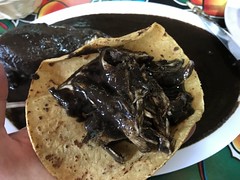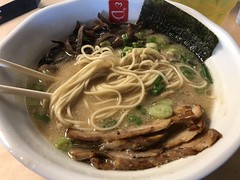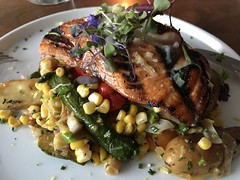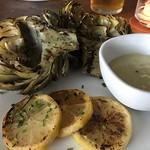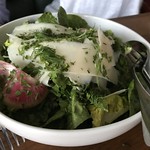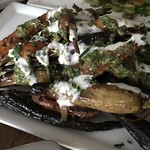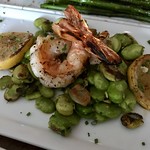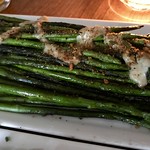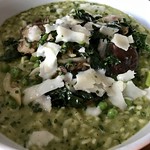Today I lunched at Gualaguetza, a piece of Oaxaca on the corner of Koreatown (only in LA). It’s all about the mole here, a thick sauce made of chilis, nuts, spices, hours of cooking, and in the negro version, chocolate. When you sit down, tortilla chips come covered in a sweet rich mole coloradito with queso fresco. There’s Oaxacan chocolate mixed with atole (a hot ground corn drink) called champurrado. And the main event, a chicken breast in a pool of rich mole negro, with rice, and corn tortillas with browned spots from the comal. And of course the Copa Mundial on the big screen, fun to watch with a crowd. I watched the Swiss beat Serbia. This place will be crazy fun tomorrow morning when Mexico plays South Korea! I definitely want to come back and try some more things, as there's quite an array of Oaxacan specialties, including chapulines (fried grasshoppers!). I'm intrigued, but also squeamish. (In the film "City of Gold", there's a scene with Jonathan Gold and Ruth Reichl munching on a plate of chapulines at this very restaurant, and talking about how we'd best get more used to eating insects, as it's our future.) I'd also try their cafe de olla next time, which might be a better way to cut the richness of the mole. Truth be told, the champurrado, a dish I'd never tried before, wasn't my favorite. I do love atole and who doesn't love chocolate. But I just didn't find the combination to be complimentary. And certainly not the 2+2=5 that you get from chocolate and peanut butter, or chocolate and hazelnuts, or even Guinness stout and chocolate (an awesome gelato). Or of course chocolate and chili in this awesome mole.
Friday, June 22, 2018
Wednesday, June 20, 2018
BOOKS: Homegoing
Yaa Gyasi, who was born in Ghana but raised in Alabama, grew up with the distinctive perspective of a vicarious participation in the African-American experience of the descendants of slavery, while also having a more immediate connection to her West African roots. From this experience, she has crafted Homegoing, a beautiful, sweeping novel that captures all of that complexity by telling a story of seven generations on two continents. On the “Gold Coast” of West Africa, two centuries ago, a fortification called the Cape Coast Castle housed British governors in relative luxury while the dungeons beneath them held hundreds of slaves waiting to be loaded onto ships to the New World. Through that portal, one woman passed through the dungeons while her half-sister lived for a time above before returning to her Fante village. Homegoing tells the story of these two women and six generations of their descendants. In West Africa, the lives of the characters provide a lens on village life, the customs of the warring Fante and Ashanti peoples, the experience of European incursion and the slave trade at the source, and later, missionaries, the introduction of cocoa, and moving toward national independence. In America, her characters experience slavery, the Underground Railroad, Jim Crow, northern migration, Harlem. While all of this is as epic as a Michener novel in its scope, it doesn’t feel the weight of all that history because each chapter is a very personal story of one person in the genealogy, focused on their personal hopes, desires, frustrations, and achievements. It’s really a series of short stories linked by ancestry, and the stories are told in beautiful prose that captures the language patterns and feel of each person’s place and time, and with a lovely whiff of magical realism. I was not surprised to read that the author has mentioned Gabriel Garcia Marquez as one of her inspirations. There is some wonderful imagery around fire and the ocean. In one passage describing how evil has touched a whole family, a character explains that evil is like a net cast wide by a fisherman who keeps the fish he wants and puts the rest back, but even the released fish are no longer the same because they know they were not free. As a genealogist, I was especially intrigued by this fictional genealogy because it illustrates the many distinct challenges of tracing African-American roots, where for various reasons a person might not have known who their grandparents were, or sometimes even their parents. Gyasi’s beautiful book imagines a fantastic genealogy, making magical sense of the complexities she grew up with.
Friday, June 15, 2018
FOOD: Tatsu Ramen
On a stretch of Sawtelle in West LA you can find dozens of Japanese restaurants with different specialties, one right next to another, up to six in a row in one strip mall. Of course there are places to get ramen. Today I tried the much-vaunted Tatsu. There was a line of people waiting, but this place processes people with Tokyo efficiency, starting with iPads on the sidewalk for automated self ordering, followed by text messaging to let you know when a table is available. I went for a bowl of “Old Skool” ramen, with slices of pork, woodear mushrooms, and green onions, all in a rich tonkotsu broth. The richness of the broth is a testament to the hours and hours that they boiled the pork bones. The noodles are thin but chewy and with a wheaty flavor, almost slightly undercooked, but that’s the traditional way it’s made in Fukuoka. I slurped up every last drop.
Friday, June 08, 2018
FOOD: Ostrich Farm
Lovely evening sharing a favorite new neighborhood restaurant
with a new friend. Ostrich Farm really showcases the wonderful produce we get at our
local farmers markets, along with a few things they grow in their own garden,
in fresh light preparations, doing much on the grill. The little gem salad is
crisp and fresh, with small shavings of fennel, large shavings of pecorino, thinly
sliced watermelon radishes for color and spice, and bits of fresh dill, lightly
dressed. Artichokes are grilled with preserved lemon. Grilled prawns are served
on a generous heap of fava beans. Long thin asparagus is lightly grilled,
topped with panko gremolata and capers. Deeply roasted carrots are topped with
labneh and a pesto made from the carrot tops. A spring risotto is generously
filled with chopped vegetables. And the Pacific salmon with its satisfying hearty
grill marks is served on a spring succotash of corn, zucchini, and red pepper. In
one departure from current trends, the portions here are rather generous. The “plates”
are almost too much for one person, and even the “small plates” give plenty to
share. So it’s good to bring a friend or two. For dessert we just shared the Eton
mess, a jar filled with blackberries, lemon curd, chunks of baked meringue, and
whipped cream.
Labels:
food
Saturday, June 02, 2018
FILM: RBG
We really enjoyed RBG, a documentary about a national treasure and an inspirational life. Her pioneering experiences as one of the early women admitted to Harvard Law, her career with the ACLU Women’s Rights Project, her incredibly supportive mensch of a husband, her acing law school at the same time as being a new mother and taking care of a husband battling cancer. I mean wow, she is so amazing!
Subscribe to:
Comments (Atom)
